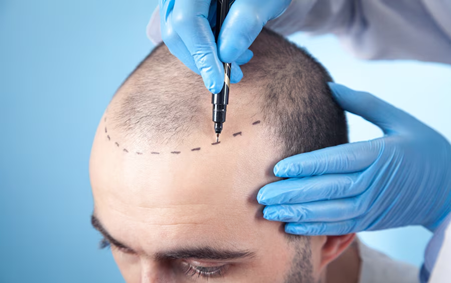It is medically known as alopecia, is a common condition that affects both men and women worldwide. It varies in severity and presentation, from thinning hair to complete baldness, and has various underlying causes. Understanding the types, causes, and treatment for hair loss is crucial for effectively managing and potentially reversing this condition.
Types of Hair Loss
- Androgenetic Alopecia (Male and Female Pattern Baldness):
- Most common type, caused by genetic and hormonal factors.
- In men, it starts with a receding hairline and thinning on the crown.
- In women, it leads to diffuse thinning across the scalp.
- Alopecia Areata:
- Autoimmune disorder where the immune system attacks hair follicles.
- Results in sudden hair loss in small, round patches on the scalp or body.
- Telogen Effluvium:
- Temporary hair shedding due to stress, illness, hormonal changes, or medications.
- Hair follicles enter the resting phase prematurely, leading to increased shedding.
- Scarring Alopecia:
- Hair loss is caused by inflammation and scarring of hair follicles.
- Results in permanent hair loss due to destruction of follicles.
Causes of Hair Loss
- Family history: It plays a significant role in androgenetic alopecia.
- Hormonal Changes: Imbalances such as during pregnancy, menopause, or thyroid disorders.
- Medical Conditions: Scalp infections, autoimmune diseases like lupus, and nutritional deficiencies.
- Physical or emotional stress: It triggers telogen effluvium.
- Medications: Side effects of certain drugs, including chemotherapy agents.
- Hairstyling and Treatments: Excessive heat, chemicals, or tight hairstyles damaging hair follicles.
Diagnosis and Treatment
- Diagnosis: A dermatologist examines scalp and hair patterns, may perform blood tests or scalp biopsy for accurate diagnosis.
- Treatment Options:
- Medications
- Topical Treatments: Creams or Injections for alopecia areata.
- Hair Transplant: Surgical procedure to transplant healthy hair follicles to balding areas.
- Lifestyle Changes: Addressing underlying health conditions, improving diet, reducing stress.
Coping with Hair Loss
- Cosmetic Solutions: Wigs, hairpieces, and hair extensions to conceal hair loss.
- Emotional Support: Counseling or support groups for coping with self-image changes.
- Self-Care: Gentle hair care practices, avoiding harsh chemicals or heat styling.
- Educational Resources: Understanding hair loss causes and treatments is necessary to make informed decisions.
Hair loss is a multifaceted condition with various types, causes, and treatment approaches. Seeking early diagnosis and treatment helps to manage hair loss effectively, restore confidence, and improve overall quality of life. Whether through medical interventions, lifestyle changes, or supportive measures, individuals experiencing hair loss have options to address and mitigate its impact on their appearance and well-being.



